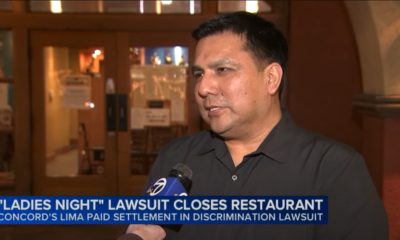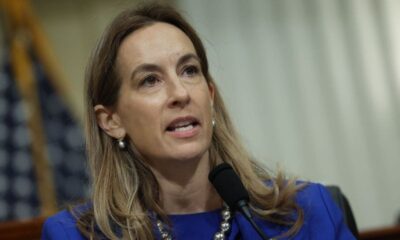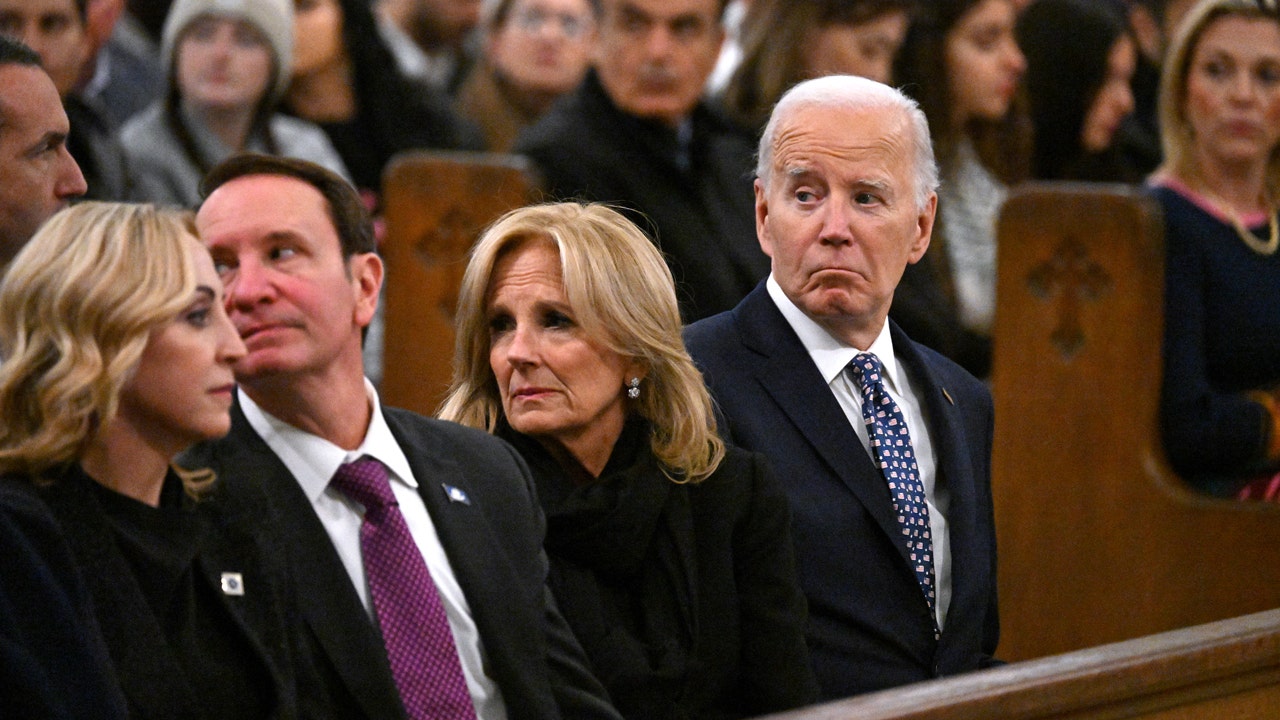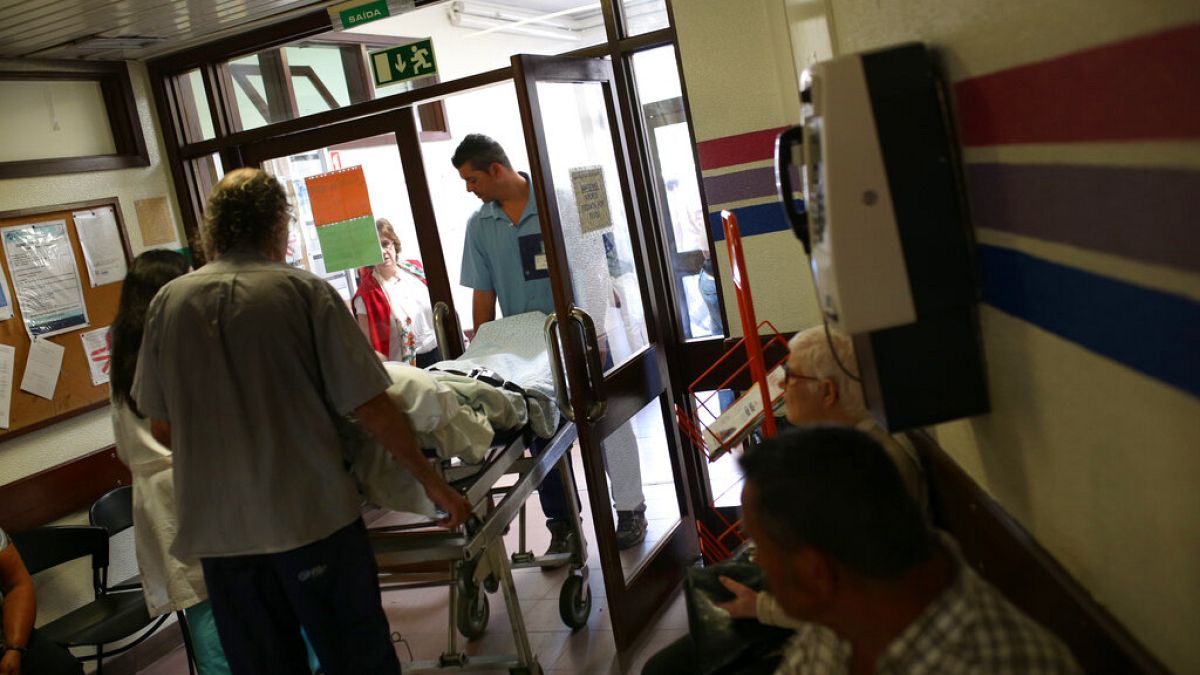California
Newsom cleans up homeless California encampments after he allocated billions of dollars while crisis grew
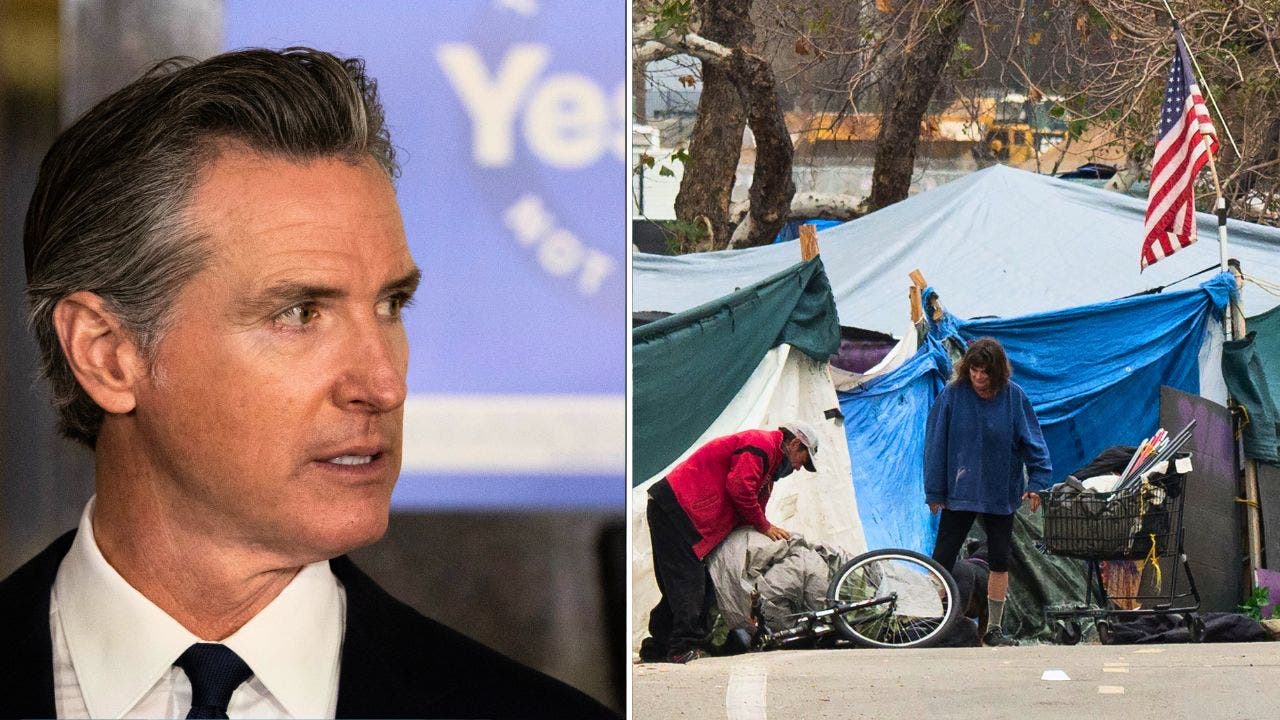
Blue state Gov. Gavin Newsom took to the streets of California to clean up trash left behind by homeless encampments Thursday, threatening municipalities that if they do not clean up encampments they’ll lose state funding next year.
A frustrated Newsom was seen picking up trash from a cleared encampment in Los Angeles — one of the largest hubs in the state for homeless people living outdoors — alongside the California Department of Transportation. California’s homelessness accounts for roughly one-third of the country’s crisis.
“I want to see results,” Newsom told reporters Thursday. “I don’t want to read about them. I don’t want to see the data. I want to see it.”
GOV NEWSOM ORDERS HOMELESS ENCAMPMENTS TORN DOWN ACROSS CALIFORNIA: ‘NO MORE EXCUSES’
Gov. Gavin Newsom, left, and people at a homeless encampment in California. (Getty Images)
Homelessness has skyrocketed in the Golden State under Newsom’s leadership. According to the 2024 point-in-time count, which provides a snapshot of homelessness on a given night, the number of homeless individuals in California increased to approximately 172,000. This represented an increse from the estimated 131,000 homeless individuals counted in 2018, the year Newsom took office.
Thursday’s announcement was a continuation of Newsom’s increasing efforts to urge local governments to conduct more sweeps of homeless encampments after the Supreme Court ruled governments can force people out of encampments. Last month, Newsom directed state agencies to begin clearing encampments from state property and has been pushing local officials to follow suit.
“We’re done with the excuses,” Newsom told reporters. “The last big excuse was, ‘Well, the courts are saying we can’t do anything.’ Well, that’s no longer the case, so we had a simple executive order: Do your job. … You’ve got the money, you’ve got the flexibility, you’ve got the green light, you’ve got the support from the state and the public is demanding it of you.”
MASSIVE CALIFORNIA RESIDENTIAL TOWER TO OFFER HOMELESS PRIVATE ROOMS, GYM, CAFE AND MORE AMENITIES

A homeless encampment in Oakland, Calif. (Getty)
But some local leaders don’t agree with Newsom’s approach. In a statement to ABC7 News, LA County officials said in part, “New bed capacity needs to be built to accommodate a population of patients who will require locked facilities when held for treatment involuntarily.
“Without first taking those steps, the work of moving people off the streets for their own health and safety would fail,” the statement continued. “This does not mean LA County is standing still. Our Pathway Home encampment resolution program already has moved hundreds of people inside as we have also extensively supported the City of LA’s Inside Safe program that has sheltered thousands of others.”
Kathryn Barger, an LA County supervisor, told the news outlet she “would love to explain to the governor what we are doing because we are.”
HOMELESS PERSON ALLEGEDLY ABDUCTS 4-YEAR-OLD AT CALIFORNIA RESTAURANT AMID UPTICK OF CRIME

A homeless encampment on the sidewalk on Hollywood Boulevard in Los Angeles. (Toby Canham for Fox News Digital)
“I’m not going to criticize the fact that he issued that order because, actually, I support what he wants to do. My goal is to have us all in the same direction. You can go in and clear the encampment, but if you don’t coordinate with the different jurisdictions around you, you’re simply moving that problem,” she said.
Earlier this year, Newsom’s administration blamed counties and cities after a state audit report found his own homelessness task force failed to track how billions of dollars have been spent trying to tackle the crisis in the last five years.
At the time, a senior spokesperson for the California Interagency Council on Homelessness (CICH), which coordinates homeless programs across the state, told Fox News Digital the audit’s findings “highlight the significant progress made in recent years to address homelessness at the state level, including the completion of a statewide assessment of homelessness programs.”

Tents and belongings at a homeless encampment in Toriumi Plaza at 1st Street and Judge John Aiso Street in Los Angeles. (Hans Gutknecht/MediaNews Group/Los Angeles Daily News via Getty Images)
Over the past five years, the CICH didn’t consistently track whether the money actually improved the situation, the audit concluded.
The spokesperson added local governments “are primarily responsible for implementing these programs and collecting data on outcomes that the state can use to evaluate program effectiveness.”
Since 2016, California has spent over $25 billion on homelessness. This includes state, local and federal funding allocated toward boosting the state’s “Housing First” ideology through various programs, which prioritizes placing people in housing first before addressing mental illness or substance abuse problems.
The Housing First model began in 2016 through SB 1380. Authored by Democratic state Sen. Ed Hernandez, the bill expanded state resources for permanent housing to homeless individuals without requirements like sobriety or employment.
CLICK HERE TO GET THE FOX NEWS APP
In a response to Fox News Digital’s request for comment, a spokesperson for Newsom referred to Thursday’s news conference and provided a statement.
“The State of California’s doing more than ever. We’ll continue to do more. But this will be my final words on this: If we don’t see demonstrable results, I’ll start to redirect money. I’m not interested in status quo any longer. And that will start in January with the January budget. We’ve been providing the support to local government that embraces those efforts and focuses on a sense of urgency — and we’re going to double down. If local government is not interested, we’ll redirect the money to parts of the state, cities and counties that are.”

California
Biden creates 2 new national monuments, setting a conservation record

A chuckwalla lizard sunbathes in this 2007 file photo from Amboy Crater National Natural Landmark in southern California. The lizard is the namesake for the new Chuckwalla National Monument.
David McNew/Getty Images
hide caption
toggle caption
David McNew/Getty Images
President Biden is creating two new national monuments in California on Tuesday, preserving the lands from development and setting a record for the most land and waters conserved by any president, the White House said.

The Sáttítla Highlands National Monument covers more than 224,000 acres in Northern California, and includes the ancestral homelands of the Pit River Tribe and Modoc Peoples. A dormant volcano is at its center, and it is home to the longest-known lava tube system in the world.
The Chuckwalla National Monument covers more than 624,000 acres south of Joshua Tree National Park in southern California, and includes sacred sites important to five groups of indigenous peoples and 50 rare species of plants and animals, including the Chuckwalla lizard.

The Chuckwalla monument is part of a corridor of protected lands stretching about 600 miles west through a total of close to 18 million acres in California, Nevada, Arizona and Utah that the White House is calling the Moab to Mojave Conservation Corridor.
In total, the White House said Biden protected 674 million acres of land and waters through monuments and other designations during his four years in office.
California
California Winds Drive Severe Fire Danger in Rain-Starved LA

(Bloomberg) — Exceptionally powerful, dry winds expected across Southern California this week are set to send wildfire risk skyrocketing in a region that’s endured more than eight months without significant rain.
Most Read from Bloomberg
Forecasters predict the strongest Santa Ana wind event of the season will start Tuesday and extend late into the week. As offshore winds race down local mountain ranges, they’ll bring gusts of up to 80 miles (129 kilometers) per hour to densely-populated communities in Los Angeles and Ventura counties, putting more than 4.5 million residents at risk, according to the US Storm Prediction Center. Downtown Los Angeles hasn’t seen more than a half-inch of rain since April, according to National Weather Service data.
“This is one of those patterns that make the hair stand up a little bit,” said climatologist Daniel Swain at the University of California Los Angeles, who called the event an “atmospheric blow dryer.” The winds, he said Monday, would be strong enough to topple trees and power lines, block roads, trigger blackouts and cancel flights at airports. “This will probably affect more people more substantially than a major rainstorm.”
In a post on X Monday, forecasters for the National Weather Service in Los Angeles warned of “life-threatening, destructive” winds in areas not typically affected by Santa Ana events. Some of the region’s most affluent and exclusive communities — such as Beverly Hills and Malibu — are included.
In some mountain passes and foothill communities, gusts could reach 100 mph, drying the air and pushing humidity levels as low as 4%, said Nick Nauslar with the US Storm Prediction Center.
“That’s going to continue for two, three, perhaps four days,” said Nauslar, the center’s fire weather science and operations officer. With this combination of factors, he said, “you’re getting into the upper echelon of Santa Ana wind events in the last couple decades.”
Months without rain have parched the Southern California landscape, leaving dry grasses, shrubs and trees that can fuel wildfires. The amount of moisture stored inside local vegetation — which can prevent it from burning — is now “well below normal and approaching record low for this time of year,” Nauslar said.
Red flag fire warnings have been issued for much of the Los Angeles area and its suburbs. But high winds will extend far beyond the city, with strong gusts expected from Shasta County in far northern California all the way to the Mexican border. Wind advisories were also posted for the hills above the San Francisco Bay Area wine country, which has suffered a series of devastating fires in recent years.
California
California Continues Targeting Food Additives, Dyes With Executive Order on Ultra-Processed Foods

California Governor Gavin Newsom has issued an executive order that mandates state agencies explore the food safety of ultra-processed foods, food dyes, and “generally recognized as safe” (GRAS) ingredients, and recommend actions to mitigate the adverse health effects.
The executive order characterizes ultra-processed foods and ingredients as “industrial formulations of chemically modified substances extracted from foods, along with additives to enhance taste, texture, appearance, and durability, with minimal to no inclusion of whole foods.” Common examples include packaged snacks, chips, crackers, cookies, candy, sugary beverages, and highly processed meats like hot dogs and lunch meats. It also calls attention to the myriad chemicals, such as food colorants, authorized for food use in the U.S., claiming that more than 10,000 such substances are currently present in the U.S. food supply, in comparison to the 300 authorized for use in the EU.
Many food chemicals enter the nation’s food supply through the U.S. Food and Drug Administration’s (FDA’s) GRAS process, which lawmakers and scientists have criticized as a “loophole” allowing potentially toxic additives in food. In a recent article by Harvard medical and law experts, the authors called GRAS a “laissez-faire approach to monitoring the safety of ingredients” that poses a threat to public health.
In this context, California has passed several precedent-setting pieces of state legislation on chemical food additives and colorants in recent years, such as the California Food Safety Act and the California School Food Safety Act.
Continuing state efforts to crack down on chemical food additives, Gov. Newsom’s latest executive order includes, but is not limited to, the following mandates:
- No later than April 1, 2025, the California Department of Public Health (CDPH) will provide recommendations to the Governor’s office regarding potential actions to limit the harms associated with ultra-processed foods and food ingredients that pose a public health risk (e.g., the inclusion of warning labels on certain ultra-processed foods)
- The Office of Environmental Health Hazard Assessment (OEHHA), in consultation with CDPH, will investigate the adverse human health impacts of food dyes, and provide a briefing to the Governor’s office no later than April 1
- No later than April 1, CDPH and OEHHA will report to the Governor’s office on the feasibility of state-level evaluation of food additives considered GRAS, as well as state actions that can be taken if companies fail to notify FDA of certain food additives through the GRAS process
The executive order also includes actions aimed at decreasing the purchase of ultra-processed foods; increasing access to healthy foods; and improving the nutrition of and increasing the amount of fresh, local-grown ingredients used in California school meals.
Some groups have previously criticized California’s approach to food additives regulation for leading the charge on an emerging patchwork of state regulations, however. For example, prior to the passage of the California School Food Safety Act, the Consumer Brands Association (CBA) stated, “[The bill] sets a dangerous precedent for state politicians to substitute their own views on food safety ahead of the scientists and risk-based review system that stringently protects America’s food supply. Americans deserve unified guidance that follows the science, not a patchwork of confusing laws.”
-

 Health1 week ago
Health1 week agoNew Year life lessons from country star: 'Never forget where you came from'
-
/cdn.vox-cdn.com/uploads/chorus_asset/file/24982514/Quest_3_dock.jpg)
/cdn.vox-cdn.com/uploads/chorus_asset/file/24982514/Quest_3_dock.jpg) Technology1 week ago
Technology1 week agoMeta’s ‘software update issue’ has been breaking Quest headsets for weeks
-

 Business6 days ago
Business6 days agoThese are the top 7 issues facing the struggling restaurant industry in 2025
-

 Culture6 days ago
Culture6 days agoThe 25 worst losses in college football history, including Baylor’s 2024 entry at Colorado
-

 Sports6 days ago
Sports6 days agoThe top out-of-contract players available as free transfers: Kimmich, De Bruyne, Van Dijk…
-

 Politics4 days ago
Politics4 days agoNew Orleans attacker had 'remote detonator' for explosives in French Quarter, Biden says
-

 Politics4 days ago
Politics4 days agoCarter's judicial picks reshaped the federal bench across the country
-

 Politics3 days ago
Politics3 days agoWho Are the Recipients of the Presidential Medal of Freedom?

